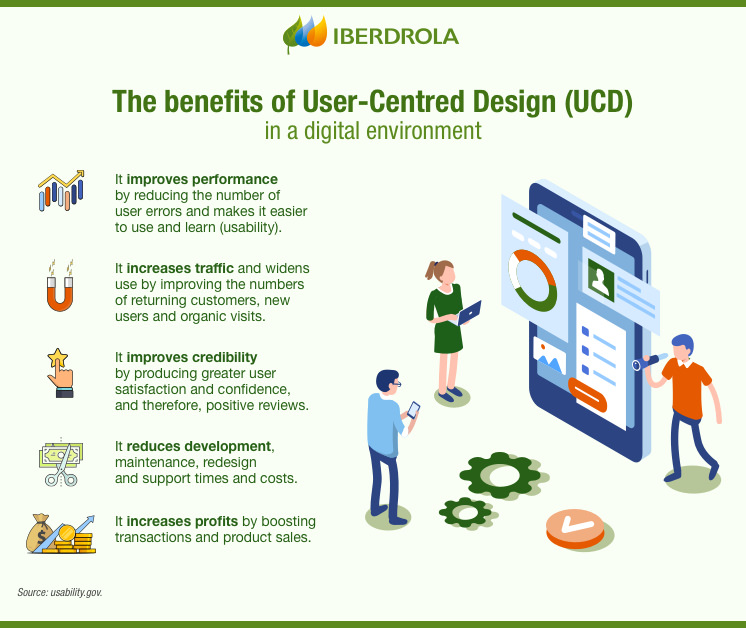USER-CENTRED DESIGN
How can design help to put the customer at the heart of the digital transformation?
Society Informatics Digital talent
In the full throes of the digital transformation, the user centric concept has found its way into the business strategies of companies the world over, for one purpose: to put the customer at the centre of their activities in order to offer them the best experience possible. One of the fundamental aspects of this concept is design, a process into which the needs and interests of users have been incorporated.

If there is one area in which digitalisation is most noticeable, it is in the business world: artificial intelligence, machine learning, the Internet of Things and, above all, Big Data, which allows us to process data and turn it into useful information for companies. Knowing users' opinions has become fundamental for companies when it comes to developing their strategies, and this affects, for example, the way they design their digital products — devices, webs, applications, etc. —.
WHAT IS USER-CENTRED DESIGN (UCD). OBJECTIVES
For several decades, products and services were designed by companies without taking the users into account. In the '90s, however, this began to change, partly thanks to the efforts of US professor, and specialist in usability engineering, Donald Norman, who highlighted two aspects that changed the world of design: the usability of products and the advantages of incorporating the real needs and interests of the user.
Norman put the user at the heart of design for the first time, thereby giving birth to the user centric era. But what exactly is User-Centred Design (UCD)? The HubSpot software developer defines it as "a process of ongoing design in which designers focus on consumers and their needs, supported by a variety of research techniques to create highly usable and accessible products".
Donald Norman, creador del término 'experiencia de usuario'
Ningún producto es una isla. Un producto es más que el producto. Es un conjunto cohesivo e integrado de experiencias
UCD has turned out to be fundamental when it comes to providing a better experience for the user and has assumed great importance for businesses in recent years. A report External link, opens in new window. from the consultants McKinsey & Company links the financial results of 300 businesses with the importance they give internally to UCD, and goes on to say that companies should think about it in strategic terms, bearing in mind these four maxims: UCD is more than a feeling, it's more than a department, it's more than a phase, it's more than a product.
External link, opens in new window. from the consultants McKinsey & Company links the financial results of 300 businesses with the importance they give internally to UCD, and goes on to say that companies should think about it in strategic terms, bearing in mind these four maxims: UCD is more than a feeling, it's more than a department, it's more than a phase, it's more than a product.
THE USER-CENTRED DESIGN (UCD) PROCESS
The User-Centred Design process involves several phases and these, with some variations depending on whether they are applied in the creation of a device, website or application, are valid for any digital product:
 Research. Specify the context for the use
Research. Specify the context for the use
Identify the user characteristics, in other words the people who will use the product, what they will use it for, and under what conditions they will use it. This means that as well as the user, the task and the environment must be considered.
 Concept. Specify the requirements
Concept. Specify the requirements
The aim is to arrive at desirable, achievable and viable solutions. This means studying users and determining a range of solutions, then starting to investigate which ones are technically achievable and how to make them financially viable.
 Design. Create solutions
Design. Create solutions
This part of the process goes from a rough concept to a complete design. From what has been learned, a lot of ideas will present themselves, opportunities will be identified, and solutions will be tested and perfected using prototypes.
 Evaluation. Test
Evaluation. Test
The sooner the design is shown to real users and their feedback is gained, the easier it is to come up with the best solution. Evaluation is as integral to UCD as quality testing is to software development.
 Launch. Monitor the product
Launch. Monitor the product
When a product is launched it needs monitoring to see if it has the desired impact. As well as looking at the qualitative indicators, it is also necessary to monitor the performance and get user feedback again.
USER-CENTRED DESIGN (UCD) TOOLS
As can be seen, UCD involves having a profound knowledge of the user. So this discipline goes hand in hand with a wide set of techniques and tools that make it possible to gather this information and achieve the best user experience or UX. In the digital sphere, this concept refers to the satisfaction that a consumer gets when dealing with a brand through the various points of contact with a company — websites, apps, bots, social media, etc. —.

SEE INFOGRAPHIC: The benefits of User-Centred Design (UCD) in a digital environment [PDF]
The main UCD methodology tools include: surveys, focus groups, usability tests, heuristic evaluations, eye tracking, web analytics, etc. User-centric and site-centric metrics are also important. The former provides precise and quantifiable data on all the users that visit a website, e.g. through the use of cookies. The latter makes is possible to obtain qualitative information, such as details about user behaviour.
Despite the help of these tools, there are a number of reasons why an IT project can fail. Susan Weinschenk, expert in user experience and author of the book Intelligent Design: 100 Things Every Designer Needs To Know About People lists the main ones: poor communication between customers, developers and users, unrealistic project targets, incorrect assessment of the necessary resources, and the use of immature technology.




